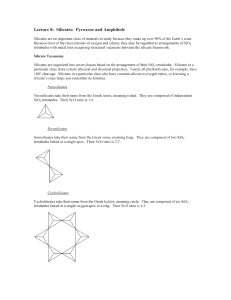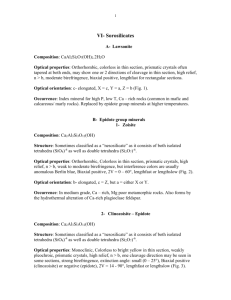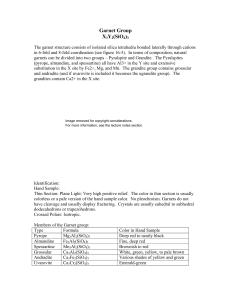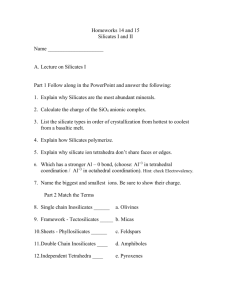Lecture 19 (12/04/2006) Part 3: Systematic Description of Minerals Silicates I: Introduction,
advertisement
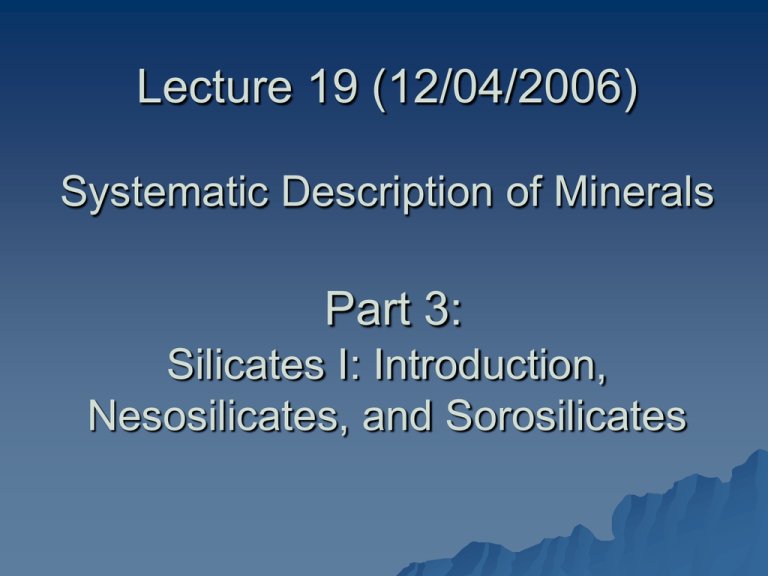
Lecture 19 (12/04/2006) Systematic Description of Minerals Part 3: Silicates I: Introduction, Nesosilicates, and Sorosilicates Predominance of Silicate Minerals in the Earth’s Crust 27% of all known minerals are silicates 40% of common minerals are silicates >90% minerals in the earth’s crust are silicates Silicon Tetrahedra – the basic building block of silicate minerals The Si-O bond – 50% covalent, 50% ionic Electrostatic Valence (e.v., measure of bond strength)=Z/CN=4/4 =1 Each tetrahedral oxygen shares a -1 charge with the tetrahedral silicon and has an extra -1 charge to share with another cation Polymerization of Silicon Tetrahedra Adjacent silicon tetrahedra can share corners, but because of the high repulsive charge of Si+4 cations, they will not share edges or faces. These shared corners are called bridging oxygens. Role of Al in Silicate Minerals Al may occur in tetrahedral (substituting for Si) or octahedral coordination Ionic radius of Al+3 = 0.39Å (4-fold) (Si+4=0.26Å) = 0.54Å (6-fold) Ionic Al:O Radius Ratio (4-fold) =0.39/1.36=0.286 (Upper limit of tetrahedral coordination RR=0.225) Ionic Al:O Radius Ratio (6-fold) = 0.388 (Upper limit of octahedral coordination RR=0.414) Bond strength - e.v. = 3/4 in tetrahedral coord. = 3/6=1/2 in octahedral coord. O-coordination and Bond Strength of Other Common Cations in Silicate Minerals Electostatic Valence w/ O-2 1/8 - 1/12 Weak 1/6 - 1/8 1/3 – 1/4 1/3 1/3 1/3 1/2 2/3 1/2 3/4 1 Strong Silicate Mineral Classification (based on arrangement of SiO4 tetrahedra) Nesosilicates (Island) x(SiO4) Unit Composition Isolated, but tightly packed (SiO4)4- tetrahedra Forms silicate minerals with: High density and hardness Equidimensional habits Poor cleavage Low degree of Al substitution with Si Olivine Garnet Common Nesosilicates: Olivine (Mg,Fe)2SiO4 High-T igneous mineral, common in mafic and ultramafic rocks; commonly alters to serpentine Vitreous olive green (Mg) to black (Fe) Equigranular to prismatic habit; poor cleavage Optics: Colorless, biaxial (+Mg, -Fe), mod. high relief (n~1.7), high 2V, ~.05 (2nd order IF colors) Complete solid solution between Mg and Fe Common Nesosilicates: Garnet (Mg,Fe,Mn,Ca)3(Fe3+,Cr,Al)2Si3O12 As mod-T metamorphic mineral formed from Al-rich source rocks and ultramafic mantle rocks (eclogites) Equigranular, euhderal to subhedral habit; poor cleavage Optics: Colorless, isotropic, high relief (n~1.7-1.9) Complex solid solution with the following end-member compositions and their characteristic colors: Pyrope Mg3Al2Si3O12 – deep red to black Almandine Fe3Al2Si3O12 – deep brownish red Spessartine Mn3Al2Si3O12 – brownish red to black Grossular Ca3Al2Si3O12 – yellow-green to brown Andradite Ca3Fe2Si3O12 – variable-yellow, green, brown, black Uvarovite Ca3Cr2Si3O12 – emerald green Common Nesosilicates: The Aluminosilicates Kyanite, Sillimanite, Andalusite Al2SiO5 Moderate to high grade metamorphic minerals formed from Alrich source rocks Al in octahedral or a mix of octahedral to tetrahedral sites. Kyanite – Vitreous bluish bladed tablets w/ single perfect cleavage; H: 5-7 Sillimanite – Vitreous brown to green clustered prisms w/ single cleavage dir. Andalusite – Vitreous flesh-red, reddish brown square prisms; H: 7.5 Common Nesosilicates: Staurolite Fe2Al9O6(SiO4)4(O,OH)2 Moderate to high grade metamorphic mineral formed from Al-rich source rocks Resinous to vitreous (dull when altered) reddish-brown to brownish black 6-sided prisms; commonly forms interpenetrating twins Optics: Biaxial(-), yellow pleochroic, high relief (n~1.75), 2V=82°-88° Common Nesosilicates: Sphene (Titanite) CaTiO(SiO4) Common accessory mineral in felsic igneous rocks and in some metamorphic rocks Resinous to adamantine gray, brown, green, yellow or black lens crystals; distinct diamond-shaped cleavage; H: 5-5.5 Optics: Biaxial(+), yellow pleochroic, very high relief (n~2.0), 2V=27°, = 0.13 Sorosilicates (Double) x(Si2O7) Unit Composition Double silicon tetrahedra linked by one bridging oxygen Commonly also contains island tetrahedra (SiO4) Typically monoclinic symmetry Most important phase of this silicate group is Epidote/Clinozoisite Epidote Structure Common Sorosilicates: Epidote Group Zoisite/Clinozoisite – CaAl3O(SiO4)(Si2O7)(OH) Epidote – Ca(Fe,Al)Al2O(SiO4)(Si2O7)(OH) Common accessory and alteration mineral in igneous rocks and is a common phase in various grades of metamorphic rocks Zoisite – Orthorhombic; Clinozoisite and Epidote – Monoclinic Physical Properties: prismatic vitreous crystals to very fine resinous massive granules; H: 6-7 Zoisite: Gray, greenish brown (pink-thulite) Clinozoisite: Gray, pale yellow, pale green, colorless Epidote: Pistachio green to yellow green, Optics: Zoisite: Biaxial(+), high relief (n~1.7), 2V=0-70°, ~ 0.005 Clinozoisite: Biaxial(+), high relief (n~1.7), 2V=14-90°, ~0.010 Epidote: Biaxial(-), high relief (n~1.75), 2V=74-90°, ~0.015.051, green-yellow pleochroic; Common Sorosilicates: Lawsonite, Vesuvianite (Idiocrase) Lawsonite – CaAl2(Si2O7)(OH)2·H2O Common mineral in high pressure metamorphic rocks; occurs with glaucophane, chlorite, and epidote Vitreous to greasy, bluish tabular to prismatic crystals, commonly twinned; H: 8 Optics – biaxial(+), mod. high relief (n~1.67), 2V=84°, ~0.02 Vesuvianite – Ca10(Mg,Fe)2Al4(SiO4)5(Si2O7)2(OH)4 Common mineral found in thermally metamorphosed limestone with garnet, wollastonite (Ca-pyroxene), and diopside (Mg-Ca-pyroxene) Vitreous to resinous, green to brown, columnar to granular crystals, commonly striated parallel to columns; H: 6.5 Optics – uniaxial(-), mod. high relief (n~1.67), 2V=84°, ~0.003-.006 Next Lecture 12/06/06 Systematic Description of Minerals Part 4 Silicates II:Cyclo-, Ino-, Phyllo-, and Tecto-silicates Read: Klein Parts of Chaps. 11 & 12
